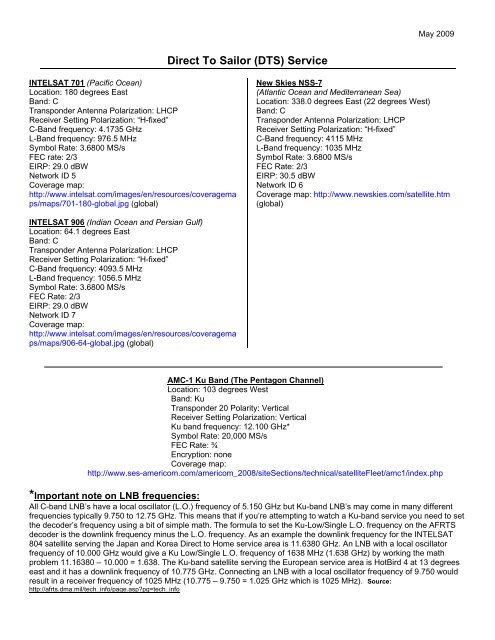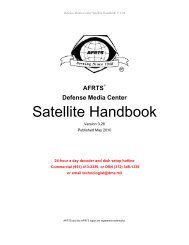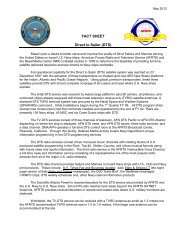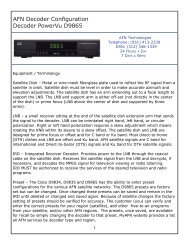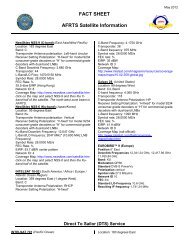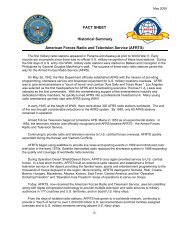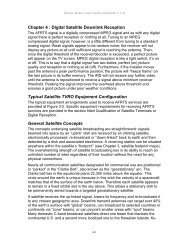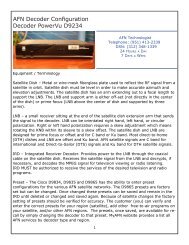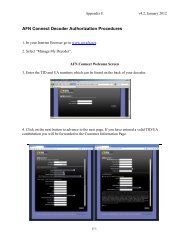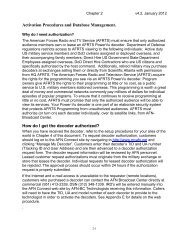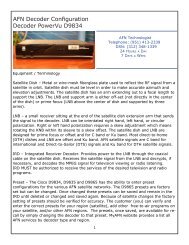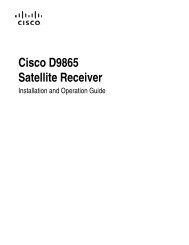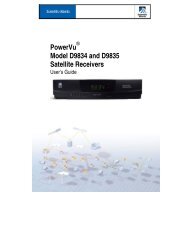FACT SHEET AFRTS Satellite Information
FACT SHEET AFRTS Satellite Information
FACT SHEET AFRTS Satellite Information
Create successful ePaper yourself
Turn your PDF publications into a flip-book with our unique Google optimized e-Paper software.
INTELSAT 701 (Pacific Ocean)<br />
Location: 180 degrees East<br />
Band: C<br />
Transponder Antenna Polarization: LHCP<br />
Receiver Setting Polarization: “H-fixed”<br />
C-Band frequency: 4.1735 GHz<br />
L-Band frequency: 976.5 MHz<br />
Symbol Rate: 3.6800 MS/s<br />
FEC rate: 2/3<br />
EIRP: 29.0 dBW<br />
Network ID 5<br />
Coverage map:<br />
http://www.intelsat.com/images/en/resources/coveragema<br />
ps/maps/701-180-global.jpg (global)<br />
INTELSAT 906 (Indian Ocean and Persian Gulf)<br />
Location: 64.1 degrees East<br />
Band: C<br />
Transponder Antenna Polarization: LHCP<br />
Receiver Setting Polarization: “H-fixed”<br />
C-Band frequency: 4093.5 MHz<br />
L-Band frequency: 1056.5 MHz<br />
Symbol Rate: 3.6800 MS/s<br />
FEC Rate: 2/3<br />
EIRP: 29.0 dBW<br />
Network ID 7<br />
Coverage map:<br />
http://www.intelsat.com/images/en/resources/coveragema<br />
ps/maps/906-64-global.jpg (global)<br />
Direct To Sailor (DTS) Service<br />
May 2009<br />
New Skies NSS-7<br />
(Atlantic Ocean and Mediterranean Sea)<br />
Location: 338.0 degrees East (22 degrees West)<br />
Band: C<br />
Transponder Antenna Polarization: LHCP<br />
Receiver Setting Polarization: “H-fixed”<br />
C-Band frequency: 4115 MHz<br />
L-Band frequency: 1035 MHz<br />
Symbol Rate: 3.6800 MS/s<br />
FEC Rate: 2/3<br />
EIRP: 30.5 dBW<br />
Network ID 6<br />
Coverage map: http://www.newskies.com/satellite.htm<br />
(global)<br />
AMC-1 Ku Band (The Pentagon Channel)<br />
Location: 103 degrees West<br />
Band: Ku<br />
Transponder 20 Polarity: Vertical<br />
Receiver Setting Polarization: Vertical<br />
Ku band frequency: 12.100 GHz*<br />
Symbol Rate: 20,000 MS/s<br />
FEC Rate: ¾<br />
Encryption: none<br />
Coverage map:<br />
http://www.ses-americom.com/americom_2008/siteSections/technical/satelliteFleet/amc1/index.php<br />
*Important note on LNB frequencies:<br />
All C-band LNB’s have a local oscillator (L.O.) frequency of 5.150 GHz but Ku-band LNB’s may come in many different<br />
frequencies typically 9.750 to 12.75 GHz. This means that if you’re attempting to watch a Ku-band service you need to set<br />
the decoder’s frequency using a bit of simple math. The formula to set the Ku-Low/Single L.O. frequency on the <strong>AFRTS</strong><br />
decoder is the downlink frequency minus the L.O. frequency. As an example the downlink frequency for the INTELSAT<br />
804 satellite serving the Japan and Korea Direct to Home service area is 11.6380 GHz. An LNB with a local oscillator<br />
frequency of 10.000 GHz would give a Ku Low/Single L.O. frequency of 1638 MHz (1.638 GHz) by working the math<br />
problem 11.16380 – 10.000 = 1.638. The Ku-band satellite serving the European service area is HotBird 4 at 13 degrees<br />
east and it has a downlink frequency of 10.775 GHz. Connecting an LNB with a local oscillator frequency of 9.750 would<br />
result in a receiver frequency of 1025 MHz (10.775 – 9.750 = 1.025 GHz which is 1025 MHz). Source:<br />
http://afrts.dma.mil/tech_info/page.asp?pg=tech_info


